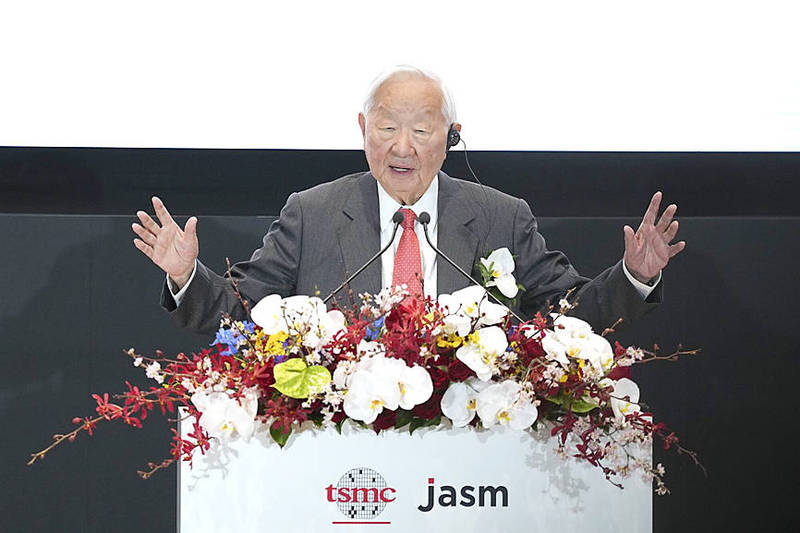《TAIPEI TIMES》 TSMC launches Kumamoto chip fab

Taiwan Semiconductor Manufacturing Co founder Morris Chang speaks during the opening ceremony for a Japan Advanced Semiconductor Manufacturing Inc factory in Kikuyo, Japan, yesterday. Photo: Bloomberg
GREAT EXPECTATIONS: TSMC founder Morris Chang said he has high hopes for the new fab, based on his experience in Japan 56 years earlier, and amid high demand for AI
By Lisa Wang / Staff reporter, in KUMAMOTO, Japan
Taiwan Semiconductor Manufacturing Co (TSMC, 台積電) yesterday held an opening ceremony for its first chip manufacturing fab in Kumamoto, Japan, which it hopes will improve chip supply resilience and help Japan usher in a semiconductor renaissance.
The Kumamoto fab is slated to enter volume production in the fourth quarter of this year.
The Japanese government said it would extend its financial support of the project to include the construction of a second factory, as TSMC’s investment is crucial to its efforts to revive its semiconductor industry.
The Kumamoto fab is owned by a joint venture, Japan Advanced Semiconductor Manufacturing Inc (JASM), which is majority-owned by TSMC. Other partners include Sony Corp and Denso Corp. Toyota Motor Corp joined the venture early this month.
The second fab would use cutting-edge 6-nanometer technology to produce advanced chips to meet growing demand for artificial intelligence (AI) chips, and those used in autonomous vehicles.
“The production of advanced logic semiconductors at JASM is a significant step in both our country’s semiconductor industry and user industries,” Japanese Prime Minister Fumio Kishida said in a prerecorded video during the opening ceremony.
The Japanese government has implemented unprecedented support for the development of a domestic manufacturing base for advanced semiconductors, Kishida said.
“As a government, based on the Domestic Investment Promotion Package formulated in December last year, we will continue to swiftly implement support measures such as budget, tax system and regulatory reform,” Kishida said.
The Japanese government has said that it plans to offer about ¥1.2 trillion (US$7.97 billion) in subsidies for the two Kumamoto fabs.
The construction of the Kumamoto factory went surprisingly well, as it took only one-and-a-half years rather than the 10 years it usually takes for a ¥1 trillion project like this one, Kumamoto Prefecture Governor Ikuo Kabashima said during the ceremony.
During a speech, TSMC founder Morris Chang (張忠謀) said the event reminded him of his first trip to Japan 56 years ago, while he was serving as an integrated circuits executive at Texas Instruments Inc.
He was there in 1968 to talk with Sony cofounder Akio Morita about starting a joint venture, Chang said.
Morita told him he would be pleasantly surprised about the yield he would achieve in Japan, he said.
That prediction came true, and at its height, Texas Instruments operated three semiconductor factories in Japan, he said.
Fifty years after his conversation with Morita, he is again waiting to see if he “will be pleasantly surprised by the yield,” Chang said.
It would be harder this time, because TSMC has a good yield in Taiwan, but he still has high hopes for JASM, he said.
The new JASM fab would “improve the resilience of the chip supply for Japan and for the world,” Chang said. “It will also, I hope and I believe, start a renaissance of semiconductor manufacturing in Japan.”
Semiconductors will be “very much-needed in the future,” driven by demand for AI applications, he said.
AI chip demand would be enormous, requiring tens of thousands wafers and 10 fabs, he said.
新聞來源:TAIPEI TIMES

Japanese Prime Minister Fumio Kishida speaks at the opening ceremony of a Japan Advanced Semiconductor Manufacturing Inc advanced wafer fab in Kikuyo, Japan, in a prerecorded video yesterday. The company is majority owned by Taiwan Semiconductor Manufacturing Co. Photo: CNA

Japan Advanced Semiconductor Manufacturing Inc’s logo is pictured on its new factory in Kumamoto, Japan, yesterday. Taiwan Semiconductor Manufacturing Co is its majority owner. Photo: Lisa Wang, Taipei Times


















